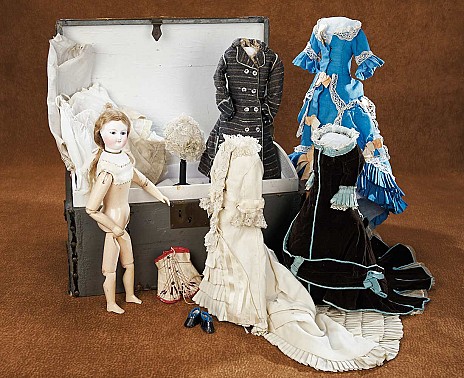Important Original Artwork,Ephemera and Dolls Related to Flora McFlimsey by Mariana
Lot #123
Comprising two hand-made cloth dolls,one 18" with firmly-stuffed head,mohair wig,and
loosely-loop-jointed limbs,wearing her original velveteen dress and fancy matching
bonnet,undergarments,shoes and socks,and one 10" with yarn hair,both with oil-painted
complexions and highly-stylized facial features to personify Flora as shown in the Mariana
books. Along with 12 original watercolor paintings by Mariana,including characters,pets and
scenes from the story books as well as an intriguing set of watercolor samplers; each is signed
by the artist. And with nine Flora McFlimsey books written between 1949-1965: Christmas
Eve,Baby New Year,Easter Bonnet,Birthday,Little Laughing Water,Little Red
Schoolhouse,Valentine,May Day,and Halloween,and three additional Mariana books: Journey of
Bangwell Putt,Doki,and Hotspur. And with a folio of paper ephemera including letters from
Mariana to the present owner,reprint of a Life magazine article from September 1952,and
more. Also included is a red wooden doll chair upon which the Flora doll sat in Mariana's
home,and a petite 9" French bisque poupee that also belonged to Mariana. The books are in
fair to good well-read and loved condition,the larger doll is excellent with small nose rub,the
smaller doll has extensive craquelure,the bisque doll has a serious crack on the forehead,the
art work is in very fine condition. About Mariana,the Artist-Writer: Marian Foster Curtis was
born in a small town at the end of the 19th century. At an early age obliged to choose
between piano or drawing lessons she "chose what seemed the lesser of two evils",drawing.
Her love of art developed and continued into studies at the Art Students League in New York
and into free-lance work for the New York Herald Tribune. "When the Great Depression hit I
got a job on the American Index Project of the W.P.A'.". We made factual drawings of Early
Americana' at the museums and here I discovered the fine craftsmanship and beauty of pre-
mass-production days. It was the old toys which charmed me most...especially the old dolls
in their faded elegance". During that work project,Mariana discovered an old cloth doll at the
New York Historical Society named for the heroine of the 19th-century poem "Miss Flora
McFlimsey of Madison Square" about a young lady who had silk and velvet gowns galore,but
"nothing to wear,nothing to wear". Inspired by that doll,Mariana went on to write and illustrate
nine children's books about the adventures of her own Miss Flora McFlimsey who she
described in a 1952 article in Life Magazine as "a cross between Queen Victoria and Mae
West". Her simple line drawings feature a doll with large O-shaped pupil-less eyes and a prim
little mouth. Those same features are present in the two cloth dolls that she made,inspired by
her drawings. Mariana died in 1978 in East Hampton,Long Island at the age of 86. In the
garden of her East Hampton home still stood the large one-room playhouse of her youth. It
was said that during her writing years the playhouse served as her muse,and during the
summer months she moved into the child scaled playhouse along with a full-size cot,a
chair,and all her drawings,writings,and dolls.,and all her drawings,writings,and dolls. Lee &
Shepard Co. and for a number of years were printed,re-printed,and finally grew out-of-print.
About the collection: As a young girl,Linda Mumew Ruskoski,didn't much like to read. So
when the Bookmobile came to her second-grade classroom she searched for books with nice
illustrations,and spotted the book Miss Flora McFlimsey's Christmas Eve'. She relates,"After
dinner,I sat in the living room and began to read this special story about a doll that had been
relegated to the attic and forgotten. Then,thanks to Santa,she began life anew...I loved
pouring over all of the accessories on the pages. It has always been one of my favorite
illustrations. I can't tell you how many times that little book was read and reread." And Linda
began a life-long love of reading. At that time,her father worked in offices at the Plaza
Hotel,near FAO Schwarz where the children's books were sold and each time a new Miss Flora
McFlimsey book was published it was added to her book shelf. Years later,Linda relates "I
decided to write Mariana a letter,sharing with her that I did not like to read until I discovered
her books. Well,Mariana wrote me back! We became friends! ....Spending time with her was
incredibly special to me. She was so modest and humble,like Flora". During the coming
year,Linda determined that the books must be reprinted,and began a dedicated drive to that
end. The anecdotal details of that project are outlined in hand-written correspondence from
Mariana. Only one year later,in 1978 Mariana died. Shortly before her death,a large box
arrived at Linda's home. "Carefully,I opened the package and inside was the doll,Miss Flora
McFlimsey,a smaller Flora and a French fashion doll name Mamselle'....Mariana had made the
two Flora's herself to use as models for her illustrations". In addition,Mariana had given to the
young teacher a number of her hand-colored artworks. As for the books in this
collection,they are all the childhood property of Linda Mumew Ruskoski,cherished these many
years,except for the book "Hotspur" which has a hand-drawn image on the inside front page
and the message "A Merry Christmas from Hotspur,To Linda,Mariana". The dolls,artwork,and
books have been in the private possession of Linda Ruskoski until this time,and are
exceptional documentary and poignant ephemera of one woman's work.











































































































































































































































































































